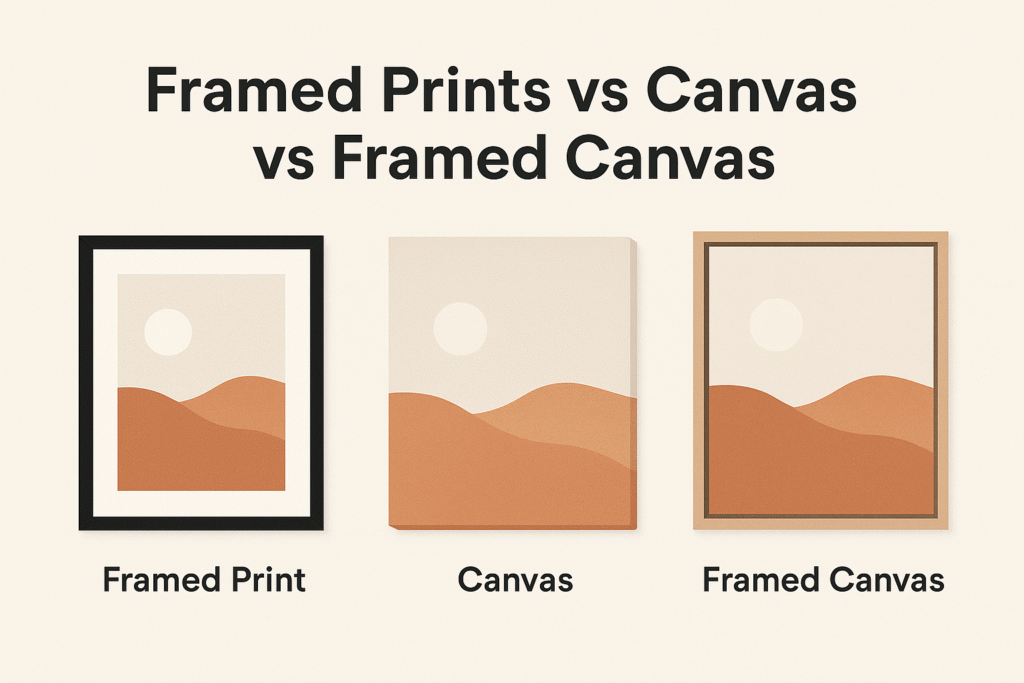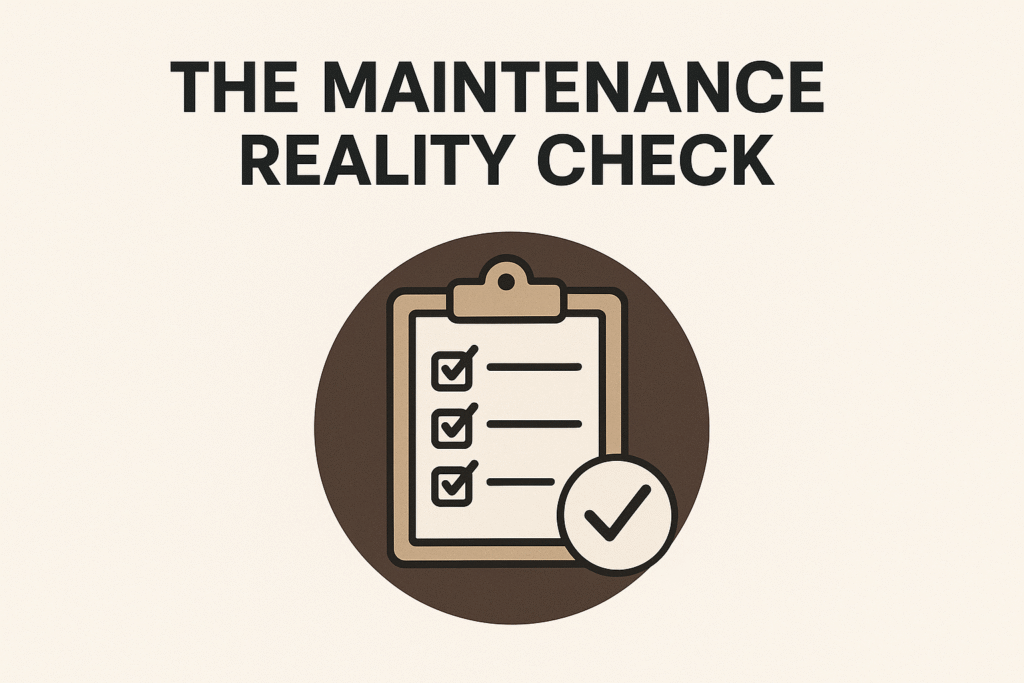You’ve probably stood in front of a wall, art in hand, wondering to choose between framed prints, canvas, or framed canvas wall art. You’re not alone. Most people guess and either are happy with their guesswork or they regret it later. Here’s how to choose the right wall art for your home the first time, based on function, not guesswork or frustration.
Learn to Select the Wall Art Style that Fits Your Home Best
Let me tell you about Sarah.
She spent three hours in a gallery last month searching for art to purchase, yet she walked out with nothing. Not because she didn’t like the art. But because she couldn’t decide between framed prints, normal canvas, or the new framed canvas everyone’s posting on Instagram.
The salesperson gave her the usual speech about “personal preference” and “following your heart.”
Useless.
Here’s what nobody tells you: The decision between these three formats isn’t about taste. It’s about function. And once you understand the variables, the choice becomes obvious.

The Third Option Nobody Explains
For decades, it was simple. Canvas or framed print. Pick one.
Then galleries introduced floating frames. Canvas prints surrounded by a frame with a deliberate gap creating the illusion that your canvas is floating in mid-air.
Floater frames position the canvas edge away from the inner edge of the frame rather than having it disappear behind a traditional frame lip, creating visual depth.
Now you have three distinct options. Each solves different problems. And most people have no idea which to choose.
The Question Everyone Gets Wrong
There is question everyone gets wrong when deciding the wall art style to choose for their walls. Everyone always asks the question: “Which looks better?”
Which in my opinion is the Wrong question.
The right question should be: “Which solves my specific problem?”
Because here’s the truth: Your dining room and your kid’s playroom need completely different solutions. Your budget matters. Your wall space matters. Whether you’re renting or owning matters.
Let’s break down all three options. No fluff. Just what actually matters.
Option 1: Traditional Canvas Prints (No Frame)
Canvas prints feel modern. They look expensive. Everyone on Instagram has them.
But let’s break down what you’re actually getting.
Canvas is printed on artist-grade cotton material, stretched over solid wood stretchers, and uses fade-resistant inks that resist sunlight glare. The print wraps around the edges. No glass. No frame needed. Ready to hang.
The Real Benefits
- Canvas is exceptionally durable with strong resistance to wear and tear. The material is moisture-resistant and suited for high-humidity environments like kitchens and bathrooms. Try that with a traditional framed print.
- Weight? Canvas prints are significantly lighter than framed photos, making them easier to hang and transport. Critical if you’re renting or rearranging frequently.
- Canvas mimics the look of original paintings, bringing sophistication without the original art price tag. People can’t tell if it’s printed or hand-painted from across the room.
The Problems Nobody Mentions
- Canvas surfaces can tear and scratch, so placement above furniture or high on walls helps prevent accidental damage. One bump from moving furniture. One kid with a toy and its done.
- We can all agree the texture of a canvas never fails to make the art look premium. However, it can sometimes work against you. Texture can be distracting if high-quality cotton canvas isn’t used. Cheap canvas looks cheap. The weave pattern overwhelms subtle details in photography or fine art prints.
- And here’s the kicker: You cannot switch out the image like in a traditional frame. With your canvas print, you’re committed. Forever.
Option 2: Traditional Framed Prints
Framed prints feel traditional. Classic. Sometimes stuffy.
But there’s a reason they’ve dominated for centuries.
Frames provide protective barriers through glass or acrylic covering that shields prints from dust, dirt, and moisture, preserving artwork quality over time. This isn’t just decoration. It’s preservation.
The Advantages That Matter
- Frames add timeless elegance, fitting perfectly into formal settings with professional polish. Your home office. Dining room. Anywhere clients or guests form impressions.
- Modern framed prints use acrylic instead of glass, making them light yet shatter-resistant. They’re simple to clean with just a damp cloth. Perfect for high-traffic areas or kids’ rooms.
- The frame itself becomes a design element. Wooden frames suit rustic interiors while sleek metallic frames work for modern settings. One piece of art. Multiple frame options. Change your style without buying new art.
The Hidden Costs
- Glass frames create glares that distract from the image, and larger framed prints become heavy and bulky, limiting placement options. That 48×36 inch print you loved so much, it weighs 40 pounds when framed. Good luck hanging it alone.
- Finding frames in certain sizes can prove difficult, potentially leading to additional expenses for custom frames. Standard sizes are cheap. Also, if you want to get an unusual dimension frame, custom framing costs more than the print.
- And maintenance is real. Dust collects under glass. Fingerprints show. You have to clean it weekly if you want it to look good.
Option 3: Framed Canvas (Hybrid)
Here’s where it gets interesting.
Framed canvas surrounds stretched canvas with a gap, giving the illusion that the canvas is floating, offering a more modern and sophisticated appearance than traditional canvas.
Think of it as the best of both worlds. Canvas texture and depth. Frame structure and polish. The visual impact of both.
The floating effect uses a narrow gap between the canvas and frame, with frames typically 1.75 inches thick, creating a contemporary gallery-style presentation.
Why Framed Canvas Format Blew Up
- The floating effect adds visual depth and ensures no part of your artwork is hidden, especially beneficial for paintings or prints with edge-to-edge details that deserve full visibility.
- Traditional frames cover your edges. Canvas wraps them around. Floating frames showcase them.
- The shadow gap creates an optical illusion that the canvas is floating and draws people’s attention to the canvas, adding to its perceived value by accentuating the stretched canvas’s depth.
The Real Advantages
- Protection without glass. Floater frames provide extra durability, protecting the edges of the canvas from accidental bumps and wear over time. No glare. No reflection. Just depth.
- Gallery credibility. Floater frames display canvas artwork the way professional galleries would, creating the illusion of a floating canvas that allows the entire work to be viewed including the sides.
- Your art looks more expensive. Period. The floating effect makes people stop and look twice.
- Frame flexibility. Don’t like black? You can switch to white or natural wood. Floating frames come in six colors using sustainably sourced framing materials. Same canvas. Different vibe.
The Downsides
- Cost. You’re paying for canvas plus frame. Expect 30-50% more than bare canvas.
- Weight increases. Not as heavy as glass-framed prints, but heavier than bare canvas.
- Wall flush issues. For decorative frames, the canvas extends slightly from the back of the frame, so the frame may not be flush against the wall. Minor detail. But worth knowing.
The Decision Framework Nobody Teaches
Forget aesthetics for a second. Start with these four variables:
1. Room Function
Room function determines everything. Bare canvas works best in casual spaces where comfort beats formality. Think bedrooms where you unwind after work. Family rooms where kids sprawl on sofas. Anywhere the vibe needs to stay relaxed and unpretentious.
Framed prints dominate formal spaces. Your home office where clients see your background on Zoom calls. Dining rooms where you host dinner parties. Anywhere you need instant credibility and professional polish. The frame itself signals intention and care.
Framed canvas bridges both worlds. It brings modern sophistication without the stuffiness of traditional frames. Perfect for living rooms that need to feel both polished and comfortable. Entryways that make first impressions without feeling cold. Master bedrooms that deserve elevation above casual but stay warmer than formal.
2. Budget Reality
Budget determines what’s actually possible versus what’s theoretically ideal. Bare canvas wins on entry price every single time. No frame needed means no frame costs. No custom sizing means no upcharges. Print it, stretch it, hang it. Done.
Traditional framed prints give you long-term flexibility that justifies higher upfront costs. Buy one quality frame for £100 and swap prints seasonally. That frame works for unlimited £20 prints over the years. Your total cost per piece drops dramatically over time.
Framed canvas costs most upfront because you’re paying for canvas quality plus frame construction. Expect 30-50% more than bare canvas. But you get maximum visual impact per pound spent. The gallery look without gallery prices. For statement pieces in high-visibility spaces, the premium pays for itself in perceived value.
3. Investment Value
Investment potential changes your format decision completely. Traditional framed prints with glass or acrylic covering help preserve artwork, especially for limited edition prints or pieces by well-known artists. Maximum protection equals maximum resale value years later.
Buying art as an investment demands traditional framed prints every time. The protection matters more than aesthetics when thousands of pounds hang in the balance. Decorating a rental property? Go bare canvas. You’ll move it in two years without damage and without hauling heavy frames up narrow staircases.
Upgrading your permanent home sits in the middle ground. Framed canvas delivers the best value here. You can add a floating frame to existing canvas prints to give current artwork a fresh, contemporary look without buying entirely new pieces. Flexibility meets permanence.
4. Environmental Factors
Environmental conditions matter more than most people realize. Canvas can be hung in areas with high humidity or temperature fluctuations without risk of warping or condensation, unlike traditional framed prints. This isn’t minor. This is the difference between art that lasts and art that gets ruined in six months.
Bathroom art requires bare canvas or framed canvas. Never traditional glass frames. Moisture from showers seeps behind glass, creates condensation, ruins prints. Same rule applies to kitchens. Cooking steam and temperature swings destroy glass-framed prints over time. Canvas handles it without problems.
Sunny south-facing walls present different challenges. All three formats work with UV-resistant inks, but canvas eliminates glare issues that plague glass frames. Nobody wants to tilt their head sideways to see art past the reflection. Canvas gives you the image without the viewing angle game.
Room-By-Room Recommendations for your Wall art options

Let’s get tactical.
Living Room
- All three work here. But framed canvas dominates modern living rooms. The narrow profiles offer a more gallery-like aesthetic than conventional frames, providing a sleek, modern look that highlights artwork without distraction.
- Large framed canvas above the sofa. Bare canvas gallery wall on adjacent wall. Traditional frames for family photos. Mix them intentionally.
Bedroom
- Bare canvas or framed canvas. Both feel warmer and less formal than traditional frames. You’re relaxing in the bedroom, not impressing clients.
- Framed canvas if you want elevated aesthetics. Bare canvas if you prioritize cost. Framed prints also work perfect in the Bedroom. This room is your personal sanctuary. You should do with it what you wish. All 3 options work just fine.
Home Office
- Framed canvas or traditional framed prints. Always. Video calls catch your background in your office. Make it count.
- Floater frames help provide definition and the gap between artwork and frame edge adds visual space to attract the eye, creating a professional gallery look.
Dining Room
- Framed canvas or traditional framed prints. This is where you host and dine. Where you entertain. Where impressions form.
- Framed canvas offers sophistication without the stuffiness of traditional frames. Traditional frames work for vintage or classical themes.
Kids’ Rooms
- In the Nursery, bare canvas or framed prints with acrylic (never glass). Safety first.
- Bare canvas costs less to replace when damaged. Framed canvas looks more finished if the room doubles as a guest room.
Bathrooms
- Bare canvas or framed canvas only. Moisture destroys traditional framed prints.
- Framed canvas elevates a bathroom from functional to spa-like. Worth the extra cost in master bathrooms.
Hallways and Entryways
- Framed canvas. Floating your canvas looks more professional and can enhance the perceived value, perfect for first impressions in your hall way.
- These are high-visibility transition spaces. Make them count.
The Maintenance Reality Check

Bare Canvas: Dust it. That’s it. Keep away from direct sunlight. Use a soft cloth. Avoid moisture.
Traditional Framed Prints: Dust the frame. Clean the glass. Check for moisture under glass. Ensure hangers stay tight. Weekly maintenance if you want it pristine.
Framed Canvas: Dust the frame. Dust the canvas. No glass to clean. Less maintenance than traditional frames. More protection than bare canvas.
The verdict: If you hate maintenance, bare canvas wins. If you want protection with minimal upkeep, framed canvas wins. If you don’t mind regular cleaning for maximum preservation, traditional framed prints win.
The Style Question (Framed Prints, Canvas or Framed Canvas)
Canvas prints feature a contemporary minimalist aesthetic with frameless design giving them clean, unadorned looks that seamlessly blend into various settings. Modern homes. Industrial lofts. Scandinavian minimalism.
Traditional framed prints offer polished, professional looks that fit beautifully into formal settings with timeless elegance. Traditional homes. Classic interiors. Formal spaces.
Framed canvas? The modern middle ground. Floating frames create a stunning visual effect with gallery-style presentation that adds a sophisticated touch to any space, offering timeless appeal.
Works in modern homes without feeling cold. Works in traditional homes without feeling dated.
But here’s the secret: Your specific style matters less than consistency. All canvas? Works. All framed? Works. All framed canvas? Works. Random mix without logic? Looks like you couldn’t decide.
Quick Reference Guide: Which Format and When
Choose Bare Canvas if you want:
- Modern aesthetic
- Lightweight and easy to hang
- Moisture-resistant for kitchens/bathrooms
- Lowest upfront cost
- Painterly, textured look
- Flexibility to move and rearrange
Choose Traditional Framed Prints if you want:
- Classic elegance
- Maximum protection for valuable art
- Professional appearance for formal spaces
- Ability to swap prints in existing frames
- Sharper detail preservation
- Investment-quality longevity
Choose Framed Canvas if you want:
- Modern sophistication with structure
- Gallery-quality presentation
- Protection without glass glare
- Maximum visual impact per pound spent
- Edge-to-edge artwork visibility
- Best of both canvas and framing worlds
What We Do At Lucid Wall Art
We offer all three formats. Because all three solve real problems.
Bare Canvas: Fade-resistant latex inks printed on 100% cotton canvas hand-stretched over solid wood stretchers. Museum-quality. Gallery-wrapped. Ready to hang.
Traditional Framed Prints: Premium archival paper with your choice of frames and matting. Glass or acrylic glazing. Custom sizes available without custom prices.
Framed Canvas: Premium floating frames using sustainably sourced materials with canvas stretched over solid pine wood, creating the professional floating effect.
Why all three? Because your bathroom needs different solutions than your dining room.
The Bottom Line
The “best” option depends entirely on your specific situation. Not your style. Not trends. Your actual needs.
Most people need all three. Different rooms. Different solutions. Different art.
The mistake isn’t choosing wrong. It’s thinking there’s one right answer.
What Actually Matters
Your walls don’t care about trends.
They care about proportion. Function. Environment. Purpose.
Value for money matters more than simply buying at the cheapest price, your home will be better off with high quality prints that work well for each room. In my opinion, its worth sacrificing to buy quality canvas or framed canvas or framed prints that will last a life time and beautify your home always.
Buy bare canvas for humid environments and budget-conscious casual spaces. Buy traditional framed for preservation and formal rooms. Buy framed canvas when you want gallery impact without gallery pretension.
Mix them intentionally based on function, not fashion.
And stop letting gallery salespeople tell you to “follow your heart.”
Your heart didn’t consider humidity levels in your bathroom, the weight load capacity of your drywall, or whether your Zoom background needs credibility.
That’s what makes the difference between art that works and art that doesn’t.

